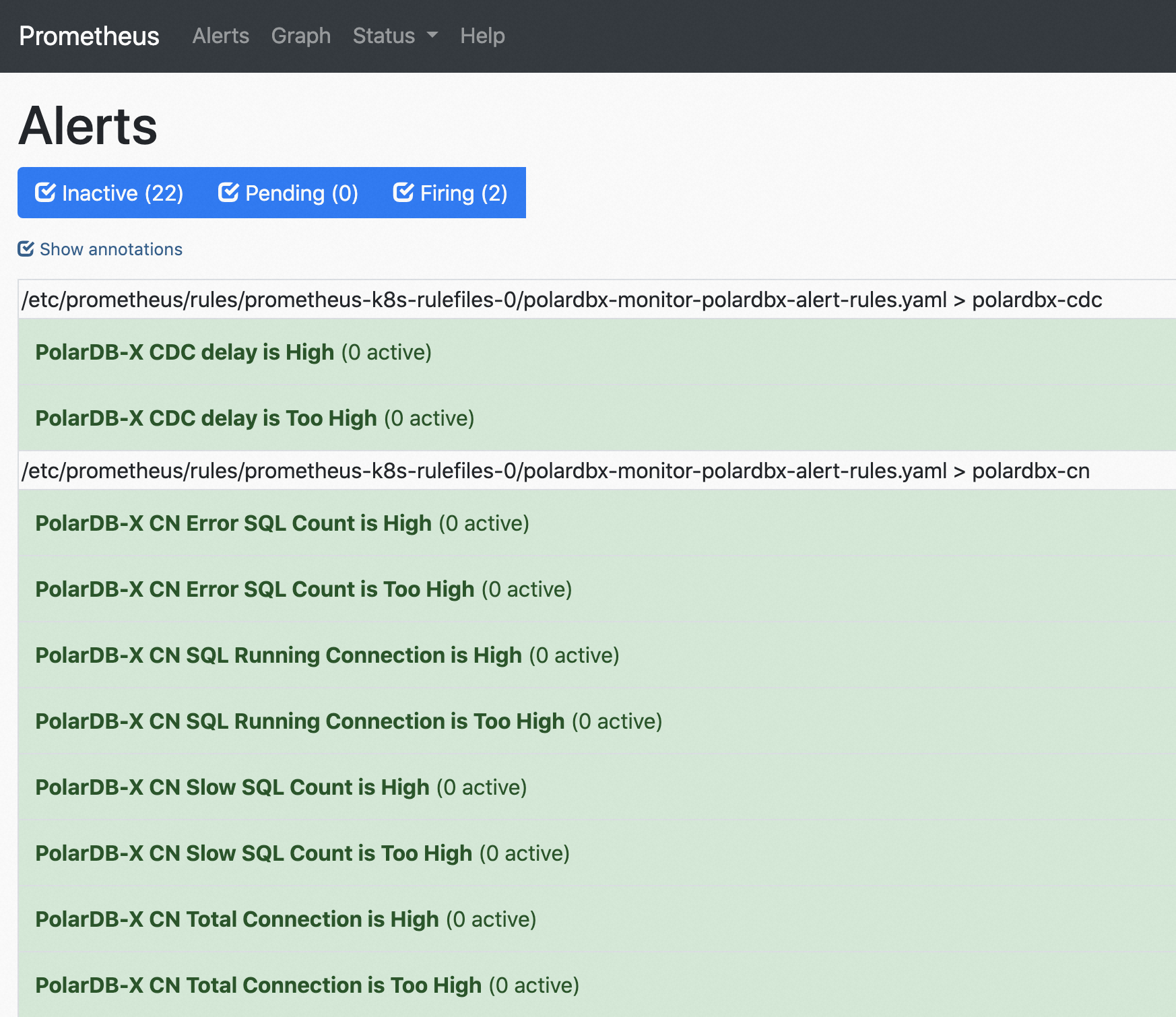Alert Configuration
The polardbx-operator, based on Prometheus + AlertManager, provides flexible alerting capabilities. This document describes how to configure alerts for clusters created by the polardbx-operator.
Prerequisites
- Install polardbx-operator and polardbx-monitor components, ensuring that the polardbx-monitor version is not lower than 1.4.0.
- Create a PolarDB-X cluster and enable monitoring by referring to the document: Enabling Monitoring for Existing Clusters.
- As sending alert messages requires access to the corresponding channel (email, DingTalk), your K8s cluster needs a machine that can access the channel's Endpoint, such as an SMTP server or DingTalk webhook.
Starting AlertManager and Accessing
PolarDB-X Operator version 1.4.0 has already integrated AlertManager and comes with out-of-the-box alerting capabilities, which can be activated in just a few simple steps.
- Prepare a machine that has access to the alert channel Endpoint and execute the following command to label the node for deploying AlertManager.
kubectl label node {node name} alertmanager=true
Replace {node name} in the command above with the NAME from the kubectl get node result.
Execute the following command to start AlertManager and deploy it on the machine with the alertmanager label.
kubectl patch alertmanager main -n polardbx-monitor --type='merge' -p '{"spec": {"replicas" : 1, "nodeSelector": {"alertmanager": "true"}}}'Execute the following command and wait for the AlertManager pod to be in Running status:
kubectl get pods -n polardbx-monitor alertmanager-main-0Execute the following command to forward the AlertManager port to your local machine and access it via a browser.
kubectl port-forward svc/alertmanager-main --address=0.0.0.0 9093 -n polardbx-monitorEnter http://{ip}:9093/ in the browser to access AlertManager.
Configuring AlertManager for Alert Push Channels
AlertManager supports the configuration of various alert push channels, see:CONFIGURATION。This document will take email and DingTalk as examples to explain how to configure AlertManager to push alerts to email and DingTalk.
Configuring Alerts to be Pushed to Email
1.Create an alertmanger-secret.yaml file and copy the following content into it:
apiVersion: v1
kind: Secret
metadata:
name: alertmanager-main
namespace: polardbx-monitor
labels:
app.kubernetes.io/instance: polardbx-monitor
app.kubernetes.io/managed-by: Helm
stringData:
alertmanager.yaml: |-
global:
smtp_smarthost: smtp.gmail.com:587 ## Email configuration for sending alerts
smtp_from: <smtp mail from>
smtp_auth_username: <username>
smtp_auth_identity: <username>
smtp_auth_password: <password>
receivers:
- name: email_receiver
email_configs:
- to: <mail to address> ## Email list to push alerts to
send_resolved: true
route:
group_by:
- job
group_interval: 5m
group_wait: 30s
receiver: email_receiver
repeat_interval: 12h
routes:
- receiver: email_receiver
group_wait: 10s
templates:
- '/etc/alertmanager/config/*.tmpl'
type: Opaque
- Modify the related configuration items in global and receivers.email_configs.to in the file above, filling in the email information for sending alert emails.
- Execute the following commands to apply the configuration:
kubectl delete -f alertmanger-secret.yaml kubectl apply -f alertmanger-secret.yaml
Configuring Alerts to be Pushed to DingTalk
AlertManager does not currently directly support DingTalk. To send messages to DingTalk, you need to deploy a DingTalk alert plugin. Through a webhook, AlertManager's messages are converted into DingTalk's alert format and sent out.
- Create a webhook robot in a DingTalk group and record the webhook URL and secret.
- Create dingtalk-webhook.yaml, and copy the following content into dingtalk-webhook.yaml:
apiVersion: v1
data:
config.yaml: |
templates:
- /config/template.tmpl
targets:
webhook1:
# Just modify the URL and secret here
url: https://oapi.dingtalk.com/robot/send?access_token=e2***
secret: SECc*****
kind: ConfigMap
metadata:
labels:
app: alertmanager-webhook-dingtalk
name: alertmanager-webhook-dingtalk-config
namespace: polardbx-monitor
---
apiVersion: apps/v1
kind: Deployment
metadata:
labels:
run: dingtalk
name: webhook-dingtalk
namespace: polardbx-monitor
spec:
replicas: 1
selector:
matchLabels:
alertmanager: true
template:
metadata:
labels:
run: dingtalk
spec:
containers:
- args:
- --web.listen-address=:8060
- --config.file=/config/config.yaml
image: timonwong/prometheus-webhook-dingtalk:v1.4.0
name: alertmanager-webhook-dingtalk
ports:
- containerPort: 8060
name: http
resources:
limits:
cpu: 100m
memory: 100Mi
volumeMounts:
- mountPath: /config
name: config
volumes:
- configMap:
name: alertmanager-webhook-dingtalk-config
name: config
---
apiVersion: v1
kind: Service
metadata:
labels:
run: dingtalk
name: webhook-dingtalk
namespace: polardbx-monitor
spec:
ports:
- port: 8060
protocol: TCP
targetPort: 8060
selector:
run: dingtalk
sessionAffinity: None
Note: The URL and secret fields on line 24 should be set to your DingTalk robot's configuration.
- Execute the following command to deploy the DingTalk alert plugin:
kubectl apply -f dingtalk-webhook.yaml
3.Execute the following command to create alertmanger-secret.yaml:
vim alertmanger-secret.yaml
Copy the content below into alertmanger-secret.yaml:
apiVersion: v1
kind: Secret
metadata:
name: alertmanager-main
namespace: polardbx-monitor
labels:
app.kubernetes.io/instance: polardbx-monitor
app.kubernetes.io/managed-by: Helm
stringData:
alertmanager.yaml: |-
global:
resolve_timeout: 5m
receivers:
- name: dingtalk-webhook
webhook_configs:
- send_resolved: true
url: "http://webhook-dingtalk.polardbx-monitor:8060/dingtalk/webhook1/send"
route:
group_by:
- job
group_interval: 5m
group_wait: 30s
receiver: dingtalk-webhook
repeat_interval: 12h
routes:
- receiver: dingtalk-webhook
group_wait: 10s
templates:
- '/etc/alertmanager/config/*.tmpl'
type: Opaque
- Execute the following commands to apply the alert configuration:
kubectl delete -f alertmanger-secret.yaml kubectl apply -f alertmanger-secret.yaml
Viewing Existing Alert Rules
Method 1:Refer to the document:View Monitoring and access the Prometheus console. By viewing the Alerts Tab, you can see the alert rules that have been configured in the system, as shown in the following image:
Method 2:
The alert rules for PolarDB-X are configured through PrometheusRule objects. Execute the following command to check the PolarDB-X PrometheusRule:
kubectl get prometheusrule -n polardbx-monitor polardbx-alert-rules -o yaml
You can also modify the alert configuration or add new alert rules in the PrometheusRule with the following command:
kubectl edit prometheusrule -n polardbx-monitor polardbx-alert-rules
